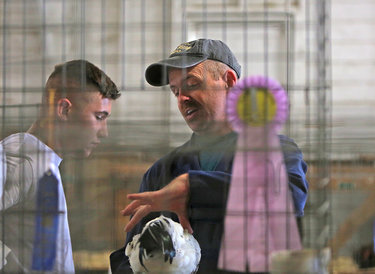Bird owners encouraged to watch out for avian flu after Hudson Valley cases identified
— Photo by RJ Anderson, Cornell Cooperative Extension
Chickens are highly susceptible to avian flu, Altamont Fair Poultry Superintendent Jeffrey L’Arche told The Enterprise this week. Cases of avian flu have been identified in the Hudson Valley, and Cornell Cooperative Extension is urging bird-owners to watch for signs of an infected flock.
ALBANY COUNTY — All bird owners should keep an eye out for signs of avian flu following the identification of cases in several Hudson Valley counties, the Cornell Cooperative Extension says.
Avian flu is an extremely contagious virus that can spread quickly through domesticated flocks. Wild birds often spread the disease to domesticated fowl, sometimes requiring owners to have infected specimens euthanized if the virus itself doesn’t cause death before it’s noticed.
In 2014 and 2015, an especially serious outbreak of the disease resulted in the death of 50 million birds across 15 states, according to an article in the Cornell Chronicle.
As a result of that outbreak, but more out of precaution than because of significant local impacts, the Altamont Fair had to cancel its annual bird show, the fair’s poultry superintendent, Father Jeffrey L’Arche, told The Enterprise this week. In 2015, that state’s Department of Agriculture and markets had banned all live fowl competitions.
It’s not yet clear whether an outbreak of that magnitude is imminent, but people should do what they can to minimize spread while the situation is still relatively mild, Stephen Hadcock, of Cornell Cooperative Extension of Albany County’s Agricultural Entrepreneurship and Market Development, told The Enterprise on Tuesday.
“In my estimation, we don’t really know how severe it really is …,” Hadcock said. “We’re trying to make sure people are aware that this is indeed a concern and that they should take appropriate measures to protect their own flocks, but we can’t really predict if we’ll have as severe an outbreak as we did in 2014, 2015.”
Hadcock said that the key is to limit contact between domesticated flocks and wild waterfowl.
“We can’t really do much about wildlife,” he said. “The only thing we can do is take measures to make sure that a backyard flock or commercial flock do not come into contact in any way with wild waterfowl.”
Hadcock added, “If a flock within a particular area is determined [by New York State Agriculture and Markets] to have the disease, then not only is that flock quarantined and observed, but any flocks in a certain geographical radius would have to be quarantined, and birds within that flock would not be able to move in or out of that quarantine area.”
And, if the virus makes its way into a flock, there’s “a high probability that your flock will be depopulated,” Hadcock said.
He advised bird owners to “work in conjunction with their own veterinarian if they have one, but definitely a state veterinarian. If a flock is positively diagnosed, Ag and Markets is going to be involved and the state veterinarian for that area is going to be called in and talk with the owner of the flock.”
Hadcock sent The Enterprise a fact sheet about avian flu that lists signs to watch out for in flocks, including:
— Lethargy and loss of appetite;
— Sudden death without other symptoms;
— Malformed eggs, or decreased egg-production;
— Swelling of the head, comb, eyelid, wattles, and hocks;
— Discoloration of wattles, comb, and legs;
— Respiratory symptoms like nasal discharge, coughing, and sneezing;
— Discoordination; and
— Diarrhea.
“In some cases,” the sheet says, “expect 100% of the flock to die within a few days. Regardless of how the disease presents, a large portion of the birds in a flock will be affected.”
But L’Arche said that these sorts of symptoms can be non-specific, meaning they can be caused by factors other than avian flu, much the same way that COVID-19 symptoms in certain people looked similar to symptoms caused by the common cold.
“It can be very confusing,” he said. “One of the most important things, if you’re raising birds, from chicks to adults, is that facilities should be clean, and they should be dry and out of the way of drafts.”
A coop that’s humid and cold can be a conducive environment for the virus, and chickens in such an area “are kind of guaranteed to come down with one thing or another.” Keeping a coop warm and dry, though, gives a chicken’s natural immune system a better chance to defend its health, he said.
L’Arche said that he’s in touch with the poultry judge who typically handles the Altamont Fair’s poultry proceedings to stay on top of local incidents, and that, as was the case in 2015 when the poultry show was canceled, it will be on the recommendation of public authorities that future events are canceled or go on as planned.
L’Arche recalled another poultry show in Massachusetts that he would go to as a kid that had been hit hard with a different type of virus that caused respiratory symptoms in birds, ultimately killing thousands of birds the week of one of the shows.
“There’s precautions now against that, but that’s why you have to be very careful,” he said.
****
Reports of avian flu in Albany County can be made to state field veterinarian Amy Willsey at 518-225-4628; the State Animal Health Diagnostic Center at 607-253-3900 or poultryhealth@cornell.edu; or the United States Department of Agriculture at 1-866-536-7593.

